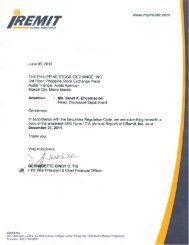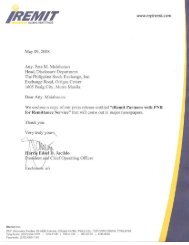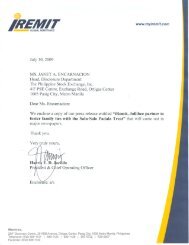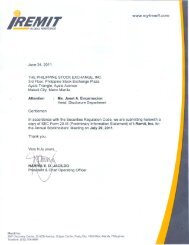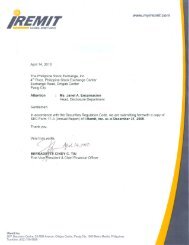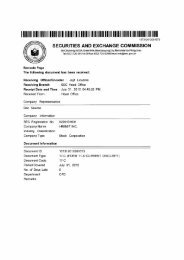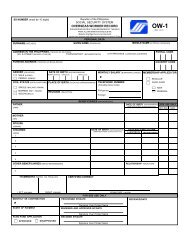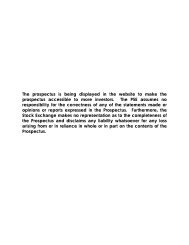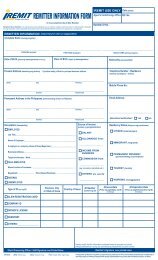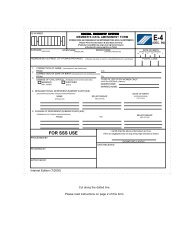SEC Form 20-IS - iRemit Global Remittance
SEC Form 20-IS - iRemit Global Remittance
SEC Form 20-IS - iRemit Global Remittance
Create successful ePaper yourself
Turn your PDF publications into a flip-book with our unique Google optimized e-Paper software.
- 27 -<br />
The following methods and assumptions were used to estimate the fair value of the financial<br />
instruments:<br />
Cash and cash equivalents, Account receivables, Other receivables, Beneficiaries and other<br />
payables and Interest-bearing loans - carrying amounts approximate fair values due to the<br />
relatively short-term maturities of these instruments.<br />
Financial assets at FVPL - fair values are based on quoted market prices.<br />
Refundable deposits - fair values are based on the present value of future cash flows discounted<br />
using prevailing interest rates ranging from 2.71% to 8.00% and 4.05% to 10.19% as at<br />
December 31, <strong>20</strong>11 and <strong>20</strong>10, respectively.<br />
Fair Value Hierarchy<br />
The Group uses the following hierarchy for determining and disclosing the fair value of financial<br />
instruments by valuation technique:<br />
Level 1: quoted prices in active markets for identical assets or liabilities;<br />
Level 2: inputs other than quoted prices included in Level 1 that are observable for the asset or<br />
liability, either directly (as prices) or indirectly (derived from prices); and<br />
Level 3: inputs that are not based on observable market data or unobservable inputs.<br />
As of December 31, <strong>20</strong>11 and <strong>20</strong>10, the financial instruments carried at fair value only pertains to<br />
the Group’s financial assets at FVPL, which consist of investments in debt and equity securities<br />
(see Note 7). The fair values of these debt and equity securities are based on quoted prices<br />
(Level 1). There were no transfers between Level 1 and Level 2 fair value measurements, and no<br />
transfers into and out of Level 3 fair value measurement in <strong>20</strong>11 and <strong>20</strong>10.<br />
5. Financial Risk Management Objectives and Policies<br />
The Group’s principal financial instruments mainly comprise of short-term loans from banks. The<br />
main purpose of these financial instruments is to raise funds for the Group’s fulfillment or delivery<br />
of remittance transactions to beneficiaries. The Group also has various other financial assets and<br />
liabilities such as cash and cash equivalents, accounts receivables, and accounts payable to<br />
beneficiaries, which arise directly from its remittance operations.<br />
The main risks arising from the Group’s financial instruments are credit risk, foreign currency<br />
risk, cash flow interest rate risk, fair value interest rate risk and liquidity risk. The BOD reviews<br />
and approves policies for managing each of these risks and these are summarized below:<br />
Credit Risk<br />
Credit risk is the risk of loss resulting from the failure of a borrower or counterparty to perform its<br />
obligations during the life of the transaction. This includes risk of non-payment by borrowers or<br />
issuers, failed settlement of transactions and default on contracts.<br />
The nature of its business exposes the Group to potential risk from difficulties in recovering<br />
transaction money from foreign partners. Receivables from agents arise as a result of its<br />
remittance operations in various regions of the globe. In order to address this, the Group has<br />
maintained the following credit policies: (a) implement a contract that incorporates a bond and<br />
advance payment cover such that the full amount of the transaction will be credited to the Group<br />
*SGVMC116502*



